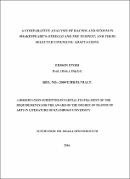| dc.description.abstract | This is a comparative study of the artistic representation of racism and sexism in two different media:
the written text and the film text. The primary texts of investigation are two ancient plays by William
Shakespeare, Othello (1604) and The Tempest (16 11 ), which are compared with their modern,
Hollywood, film adaptations of the same titles: Oliver Parker's Othello ( 1995) and Julie Taymor's
The Tempest (20 11 ). Six dramatic techniques which Shakespeare uses to portray racism and sexism in
the English society at the time of writing the two plays are compared with their six film equivalents
that are employed by the film directors to portray the same ideas of racism and sexism in adaptation.
The six dramatic techniques selected to demonstrate the tendency co treat black and female characters
as inferior human beings include: physical setting, characterization. props/costumes, blocking, special
effects/stunts and songs/music/ plus all other sound effects. The film directors innovate with filmic
techniques to recall the history of racism and sexism in England that is reproduced in a modern,
Hollywood, American setting. It is argued that the two film adaptations present a more graphic
version of discrimination against black people and women in the 20th/2 I 51 Centuries than the one
dramatized by Shakespeare in the 17th Century. It is also argued that racism and sexism are universal
themes that defy time and geographical space. The study is grounded in Kamilla Elliott' s six
"unofficial" theories of adaptation that are used to explain the power in the selected films to magnify
and accentuate representations of racism and sexism. These six theories of Elliott are: the ·'psychic,"
··ventriloquist," " incarnation," "genetic," "De (Re)-composition" and "trumping." The analysis,
however, emphasizes and focuses on the "psychic" and "ventriloquist" theories. The primary methods
of investigation include a focused reading of the literary techniques and a corresponding focus on
their filmic renditions, which help in establishing why the films have tended to exaggerate racism and
sexism. The findings are presented qualitatively in an extended analysis that describes and explains
how and why the films tend to blow up ideological representation of racism and sex ism beyond what
was envisaged by Shakespeare in his two plays. It is concluded that cinema exaggerates racism and
sexism because it employs unique, extra-representational features- both visual and sound effects that
directly impact on the viewer's senses as compared to the ways of the written texts where
meanings are implied and must be drawn from reading texts. Cinema also employs special effects and
srunts to manipulate pictures and sounds, which magnify ideas even further. The final outcome is a
depiction of graphic and exaggerated images of racism and sexism on the screen. | en_US |

